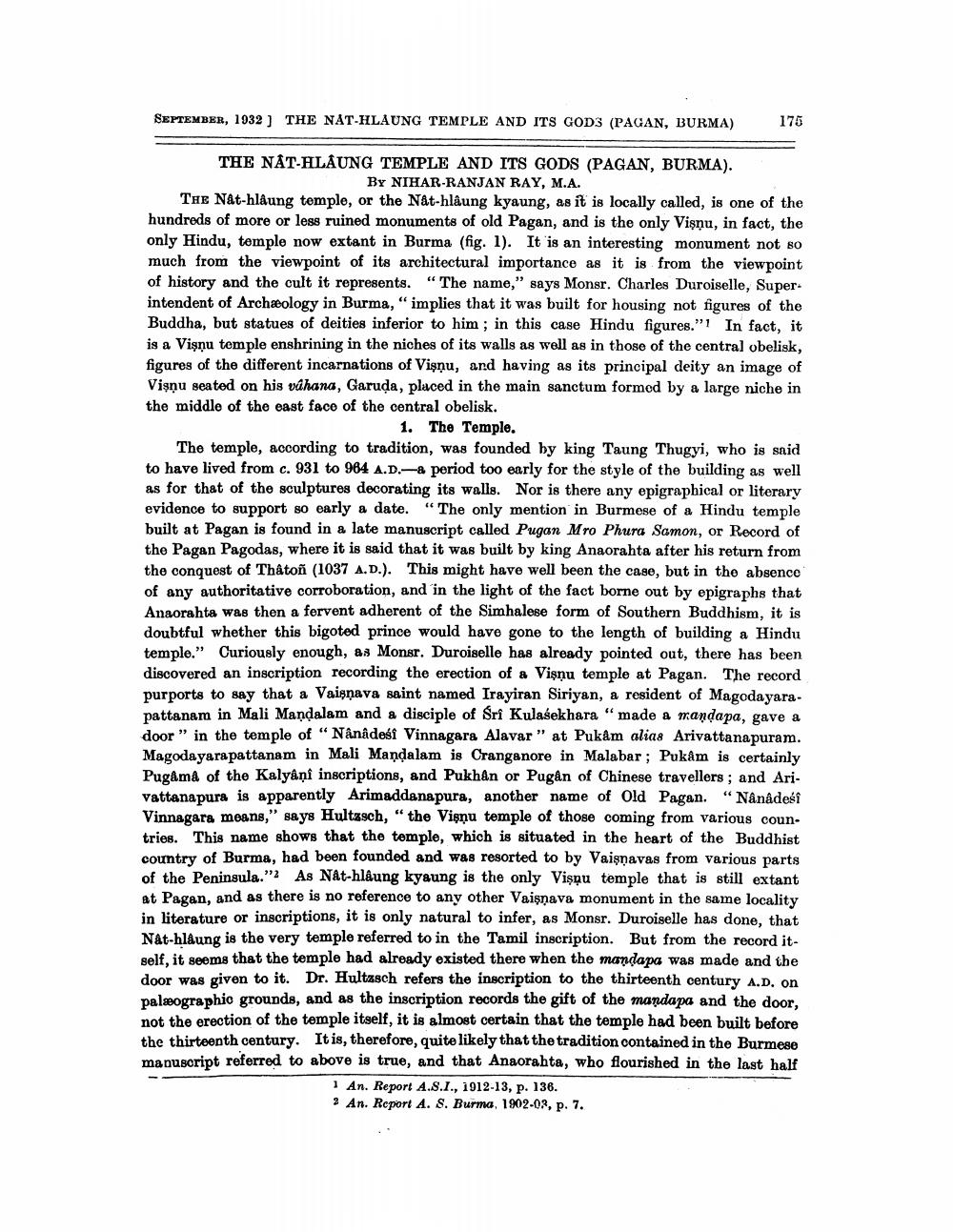________________
SEPTEMBER, 1932) THE NAT-HLAUNG TEMPLE AND ITS GODS (PAGAN, BURMA)
175
THE NÅT-HLAUNG TEMPLE AND ITS GODS (PAGAN, BURMA).
BY NIHAR-RANJAN RAY, M.A. THE Nat-hlaung temple, or the Nat-hlâung kyaung, as it is locally called, is one of the hundreds of more or less ruined monuments of old Pagan, and is the only Vişnu, in fact, the only Hindu, temple now extant in Burma (fig. 1). It is an interesting monument not so much from the viewpoint of its architectural importance as it is from the viewpoint of history and the cult it represents." The name," says Monsr. Charles Duroiselle, Superintendent of Archæology in Burma, “implies that it was built for housing not figures of the Buddha, but statues of deities inferior to him; in this case Hindu figures."! In fact, it is a Visnu temple enshrining in the niches of its walls as well as in those of the central obelisk, figures of the different incarnations of Vişnu, and having as its principal deity an image of Vişnu seated on his váhana, Garuda, placed in the main sanctum formed by a large niche in the middle of the east face of the central obelisk.
1. The Temple. The temple, according to tradition, was founded by king Taung Thugyi, who is said to have lived from c. 931 to 964 A.D. period too early for the style of the building as well as for that of the sculptures decorating its walls. Nor is there any epigraphical or literary evidence to support so early a date. “The only mention in Burmese of a Hindu temple built at Pagan is found in a late manuscript called Pugan Mro Phura Samon, or Record of the Pagan Pagodas, where it is said that it was built by king Anaorahta after his return from the conquest of Thâton (1037 A.D.). This might have well been the case, but in the absence of any authoritative corroboration, and in the light of the fact borne out by epigraphs that Anaorahta was then a fervent adherent of the Simhalese form of Southern Buddhism, it is doubtful whether this bigoted prince would have gone to the length of building a Hindu temple." Curiously enough, as Monsr. Duroiselle has already pointed out, there has been discovered an inscription recording the erection of a Vişnu temple at Pagan. The record purports to say that a Vaişņava saint named Irayiran Siriyan, a resident of Magoda yarapattanam in Mali Mandalam and a disciple of Sri Kulasekhara "made a mandapa, gave a door " in the temple of "Nânâdesi Vinnagars Alavar" at Pukam alias Arivattanapuram. Magodayarapattanam in Mali Mandalam is Cranganore in Malabar; Pukam is certainly PugamA of the Kalyani inscriptions, and Pukhán or Pugan of Chinese travellers : and Arivattanapura is apparently Arimaddanapura, another name of Old Pagan. "Nânâdesi Vinnagara means," says Hultzsch," the Vişnu temple of those coming from various countries. This name shows that the tomple, which is situated in the heart of the Buddhist country of Burma, had been founded and was resorted to by Vaişnavas from various parts of the Peninsula." As Nát-hldung kyaung is the only Vişņu temple that is still extant at Pagan, and as there is no reference to any other Vaisnava monument in the same locality in literature or inscriptions, it is only natural to infer, as Monsr. Duroiselle has done, that NAt-hlaung is the very temple referred to in the Tamil inscription. But from the record itself, it seems that the temple had already existed there when the mandapa was made and the door was given to it. Dr. Hultzsch refers the inscription to the thirteenth century A.D. on palæographio grounds, and as the inscription records the gift of the mandapa and the door, not the erection of the temple itself, it is almost certain that the temple had been built before the thirteenth century. It is, therefore, quite likely that the tradition contained in the Burmese manuscript referred to above is true, and that Anaorahta, who flourished in the last half
1 An. Report A.S.r., 1912-13, p. 136. 2 An. Report A. S. Burma, 1902-03, p. 7.




